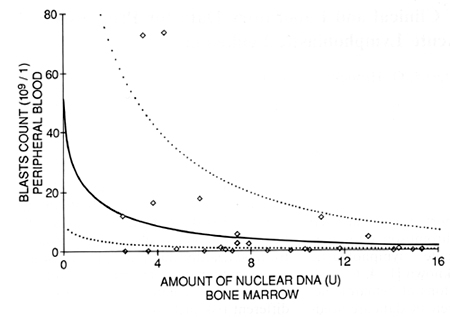Hämatol. Bluttransf. Vol 32 |
|
l Research Institute of Child Development, Department
of Genetics, Faculty of pediatrics, Charles University, Vuvalu 84,15018
Praha 5, Czechoslovakia
The prognostic importance of blast-cell DNA content and chromosomal findings in childhood acute lymphoblastic leukemia (ALL) is known [1-4, 6, 7, 9], but further correlations of hematologic, immunologic, and genetic data are needed for a better understanding of the biology of leukemic cells [5, 10]. Our pilot study is focused on the multivariate analysis of hematologic and genetic data from both a clinical and a laboratory point of view to be used for clinical prognosis in children with newly diagnosed ALL.
Twenty-four clinical and laboratory parameters were analyzed in 65 children with newly diagnosed ALL, including age, sex, mediastinal mass, WBC and blast count in peripheral blood, blast count in bone marrow, FAB classification, cytochemical, histochemical, and immunological characteristics, chromosomal findings, karyotype index, DNA index, and familial incidence of cancers. All parameters were computerized and statistical analysis including multivariate analysis was done. Data from ALL patients were compared with control data from 60 healthy children without history of any malignancy. The prognosis of the disease was calculated in relation to the different risk factors.
The absolute blast count in peripheral blood at the time of diagnosis proved to be the main prognostic risk factor in childhood ALL. Both karyotype and DNA index as well as the amount of nuclear DNA in bone marrow blasts correlated with absolute blast count in peripheral blood (Fig. 1) and are described as other important prognostic risk factors. A higher incidence of cancer in the ALL patients' families was found in comparison with the group of control children's families and seems to be another important genetic risk factor in the prognosis of childhood ALL. The significance of our findings was confirmed using multivariate analysis, which described an initial absolute blast count in peripheral blood as the most important determinant for the prognosis of ALL.

D. Discussion The prognostic importance of laboratory and clinical data in relation to leukemia has recently been discussed in the literature [2, 4, 5, 7]. The published reports indicate that genetic factors contribute to the etiology of human leukemia. Current epidemiologic knowledge supports the hypothesis that human leukemia is a disease arising from multiple causes. These complex causes include intrinsic factors (genetics and epidemiology) as well as environmental factors (irradiation, chemicals, and viruses). It would appear that no one cause is dominant and that the etiology of human leukemia is probably the result of various interactions producing a disturbance of cell division [8]. The first results of our pilot cooperative prognostic study in childhood ALL; presented here, indicate that there are different risk factors playing a role in the prognosis, but also in the cause of childhood ALL. The best direction for future prognostic investigations in childhood ALL may be the cooperation of clinical hematologists and oncologists with immunologists, geneticists, molecular biologists, and epidemiologists to clarify many different still unknown interactions of etiologic and prognostic importance.
Correlation of 24 different clinical and laboratory measures was performed for a calculation of the prognosis in 65 children with newly diagnosed acute lym phoblastic leukemia (ALL). The hematologic as well as genetic parameters were studied at the time of diagnosis. It was shown that the initial blast count in peripheral blood is the most important risk factor for the prognosis of ALL. Cytogenetic, DNA cytometric, and pedigree data correlate with blast count and also seem to be very important determinants for ALL prognosis. The statistically significant increase in the incidence of neplasms in ALL families is reported.
1. Berneman ZN, Dc Bock R, Van Alsenoy L, Vingcrhocts W, Van dcn
Bergh M, Dumon J, Peetermans M (1985) Cytogenetic and DNA-flow cytometric
studics of separated blasts. Leuk Res 9 (12): 1463-1466 |